#historicalnote
Explore tagged Tumblr posts
Video
youtube
I’m still not finished yet with my review of Episode 38 of Strange Paradise. However, I just watched this very good video on Haitian beliefs about zombies, which includes clips from authentic Vodou (voodoo) rituals.
1 note
·
View note
Photo

Bookshelf! ♡♡ linktr.ee/intrepiddudettes Or author.to/hpugh And btw Contarhuacho is #free again today on Amazon! mybook.to/cbio #whattoread #lovelife #feminism #feministwriting #feministauthor #sacredvalley #booklover #womenshistory #womeninresistance #giantsamongwomen #historygirls #womenwritingfiction #pocinhistory #indigenoushistory #storycraft #culturalnotes #historicalnotes #Spanishhistory #booksbooksbooks #creativenonfiction #ñusta #explore #learn #inspirationalwomen #smashpatriarchy https://www.instagram.com/p/CVFyr9VAdZJ/?utm_medium=tumblr
#free#whattoread#lovelife#feminism#feministwriting#feministauthor#sacredvalley#booklover#womenshistory#womeninresistance#giantsamongwomen#historygirls#womenwritingfiction#pocinhistory#indigenoushistory#storycraft#culturalnotes#historicalnotes#spanishhistory#booksbooksbooks#creativenonfiction#ñusta#explore#learn#inspirationalwomen#smashpatriarchy
0 notes
Photo

*ENGLISH VERSION BELOW*⠀ ⠀ Franz Joseph I d'Autriche (1830-1916) Empereur d’Autriche et roi de Hongrie et membre de la Maison de Habsbourg-Lorraine, il règne sur l'Autriche et la Hongrie du 2 décembre 1848 au 21 novembre 1916. ⠀ ⠀ Destiné à devenir empereur de sa naissance, il reçoit une stricte et sévère éducation militaire, qui définira sa manière de raisonner et de se comporter pour toujours.⠀ Élégant et courtois, doué d'une excellente mémoire (il parle couramment l'allemand, le français, l'italien, l'hongrois et le tchèque) et animé par un sincère sens du devoir, manque pourtant d'une propension à l'Art. L'autorité de sa mère (l'Archiduchesse Sophie) et ses idées politiques seront à la base des nombreuses choix que Franz Joseph accomplira pendant son empire. ⠀ ⠀ Franz Joseph I (1830-1916) was Emperor of Austria, King of Hungary, and monarch of other states in the Austro-Hungarian Empire. He was a member of the Habsburg dynasty and he reigned from from the 2nd December 1848 to his death. ⠀ ⠀ Destined to become emperor at birth, he receives a strict and severe military education, which will define his way of thinking and behaving forever.⠀ Elegant and courteous, endowed with an excellent memory (he speaks fluently German, French, Italian, Hungarian and Czech) and animated by a sincere sense of duty, yet lacks a propensity to Art. The authority of his mother (the Archduchess Sophie) and her political ideas will be at the root of many choices that Frank Joseph will make during his empire.⠀ ⠀ #franzjoseph #kaiserfranzjoseph #Sisi #Elisabethofaustria #Habsburg #Empire #Emperor #King #drawing #wip #comics #bd #1800s #watercolor #aquarelle #Steinkis #giorgiamarras #historicalnotes (presso Maison des Auteurs)
#aquarelle#watercolor#steinkis#emperor#elisabethofaustria#drawing#giorgiamarras#kaiserfranzjoseph#empire#habsburg#comics#wip#king#1800s#sisi#franzjoseph#bd#historicalnotes
1 note
·
View note
Photo

Hommage à Elsa von Freytag-Loringhoven, monika mausolf
http://digital.lib.umd.edu/archivesum/actions.DisplayEADDoc.do?source=/MdU.ead.litms.0009.xml&style=ead#historicalNote
https://www.saatchiart.com/art/Painting-Hommage-Elsa-von-Freytag-Loringhoven/89436/1532816/view
1 note
·
View note
Text
Episode 33 Review: The Gentle Zombie
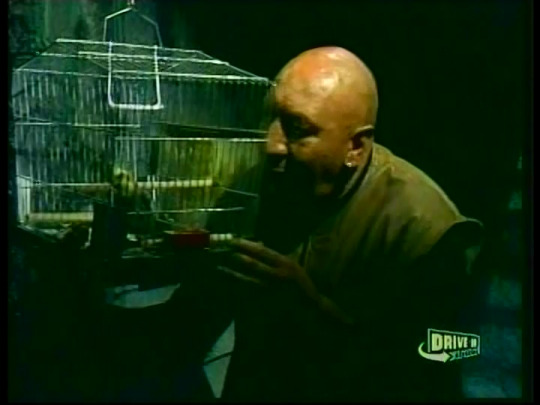
{ Not available on YouTube }
{ Synopses: Debby Graham | Bryan Gruszka }
{ Screencaps }
And now, following our over-4,000-word-long sojourn into the eerie, isolated estate of San Rafael on Tuesday, we at last return to the even eerier and even more isolated locale of Maljardin, THE DEVIL JACQUES ELOI DES MONDES’ Garden of Evil! *sting*
Once again, Colin Fox has the day off to recover from his spinal injury the year before, meaning we get another Foxless episode. Unlike some of the previous Foxless episodes, however, this one is a real treat. We get the first centered around the mysterious Quito, Jean Paul Desmond’s silent manservant, Raxl’s closest companion, and owner of the adorable Chalcko, mascot of this blog. We also finally get payoff for my least favorite Maljardin-era subplot, the saga of the Holly portrait--which, if you ask me, is long overdue--and it’s good.
The Lost Episode summary for this episode indicates that it was always intended to focus on Quito. As usual, the Cleveland Plain Dealer provides the most detailed and best summary (and I am not at all biased, despite living in Cleveland):

Source: Cleveland Plain Dealer (October 24, 1969). The “Repeat” part is a misprint, as the episode only aired once on WKBF.
Interestingly, we already saw Quito give Holly the gift of a sparkling stone three episodes ago in the aired version of Episode 30. For whatever reason, the executives and/or Ian Martin himself decided to have this event occur earlier in the series’ timeline, possibly with its original importance to the overarching story decreased. The second sentence of this summary, however, remains accurate, as you will find in this review.

Quito kissing the cryonics capsule.
The episode begins with Quito visiting Erica Desmond's capsule and bringing more flowers for her. Both the way he kisses the capsule and the fact that Jean Paul doesn’t make him give Erica flowers show that he, like Raxl, truly loves her.
After leaving the crypt, he visits the Great Hall following a painting/bickering/recap scene between Tim and Holly, to stare at the portrait of Erica--or, rather, the roughest possible approximation of her appearance, because Jean Paul has done everything in his power to make Tim’s project as difficult and frustrating as possible for him (see also my post on Episode 24). A drum pounds for suspense, he turns to face the portrait, and, just as he reaches out to touch it,

HE COLLAPSES!

Fortunately, Alison and Dan come in from outside at just the right moment for her to check his pulse. She believes him dead at first because he has no heartbeat, but then hears him breathing despite him continuing to have no pulse. She concludes, much to pragmatic lawyer Dan’s shock, that Quito must be a zombie as he once said (this is another instance where I can’t recall which episode, unfortunately).

This is what the Holly portrait looks like now, by the way.

A close-up of the face. Still looks approximately halfway between Holly’s face and Erica’s in Tim’s original sketch of her.
They leave Holly and Tim alone with Quito while they go to the lab (in Alison’s case) and the crypt to search for the missing cyanide (in Dan’s), when they hear Holly scream! Dan, who was so close to making friends with Chalcko, bolts upstairs to find the mysterious servant previously thought to be dead (un-undead?) has once again come alive. He starts to pursue Holly, but Alison stops him, so he turns around and tears the cover off the Holly portrait. “Is it Holly, or my sister Erica?” she asks herself out loud. “I can’t tell!”
The rest of this scene suggests that perhaps Quito, too, can’t tell, or at least sees too much of Erica in Holly to ignore. Most likely, that’s why he’s drawn to her and waits on her as though he were her servant as well as that of Jean Paul and Erica. Dan attributes Quito’s fainting to the shock of seeing a portrait that so captures Erica’s likeness that the uncanny resemblance between her and Holly frightens him.
Two and a half months ago, Curt of the Maljardin Blog wrote that the production crew did not cast an actress to play Erica at the beginning of the show, as evidenced by their use of crew member Lara Cochrane to play Erica’s corpse in Episodes 1 and 4. But now I wonder, what if Ian Martin originally intended for Sylvia Feigel to play Erica as well as Holly, given his frequent mention of their alleged resemblance? It seems like an odd decision, especially because I believe that Sylvia was originally destined for a dual role as both Holly and the blonde girl whom Tarasca sacrificed in her nightmare. But, if Sylvia Feigel was supposed to portray the living Erica, would that mean that Erica’s past incarnation was not Jacques’ wife Huaco, but the sacrificed girl? It wouldn’t make sense for Erica’s past counterpart to be her instead of Huaco, unless he decided to also give Sylvia her role, which would have made her Huaco’s third actress. But this is all extremely unlikely, especially because such a quadruple role seems like far too much for a single arc of a live-action series. Even Dark Shadows didn’t make its actors play four roles in the same arc.
All right. Enough of a theory that I myself don’t completely believe, even if it is possible (if improbable) that Ian Martin intended it. Matt-- who, naturally, hurried down the steps when he heard his stalkee screaming--thinks that the reason why Quito fainted upon touching the portrait was because he "sees something of Erica Desmond in [Holly]." I believe there’s more to it than that, though. There must be something supernatural going on that made him faint, something like Erica’s ghost exerting her power over him. But they never did explain this bit, so--like most of this show--it’s up to interpretation.
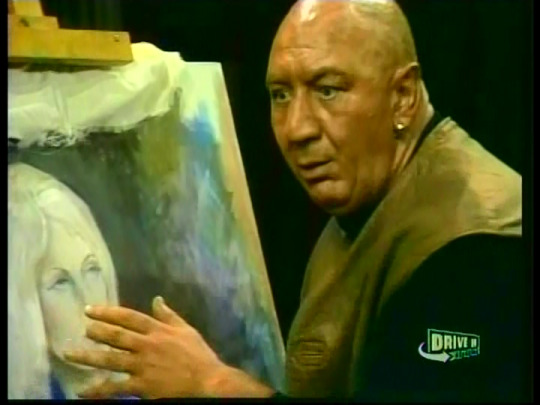
Tim: “Quito, I thought you were dead!”
Quito touches the portrait and then his heart. “Only Raxl can tell what he’s trying to tell us,” Matt claims, but Alison, too, understands the message. Quito, whom Dan calls “a soulless man,” loves Holly.
This horrifies Holly even more than Matt’s affections. She shouts “NO!” and Quito retreats to the crypt. She throws a fit, disgusted by the thought of “a monster who lunges at people” wanting a romance with her, and even accuses him of pushing her down the staircase, even though Quito was in the temple at the time.

For the Serpent’s sake, Reverend Stalker, leave her alone! The last thing she needs is your “comfort” when we know that what you really want is to get in her pants!
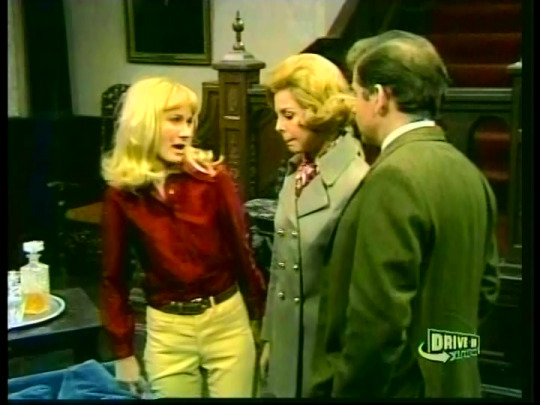
Holly: “Drag, drag, drag, the Reverend Matthew Drag!”
I’m dying of laughter at this terrible line.
Dan suggests that, if Jean Paul can’t bring Erica back to life, he may decide to replace her with Holly. We know that Jean Paul would never do that, but that his ancestor Jacques almost certainly would--at least once he got bored with his lovely witch Elizabeth/Tarasca. (I’m still not convinced, though, that he doesn’t want to make her sacrifice Holly, either just for fun or so that she--and, after their marriage, he--can get her fortune.)
Tim begs to differ about the painting’s resemblance to Erica, once again lampshading the absurdity of the whole situation. You have an artist painting a portrait of a dead woman, using a living one as his model who may or may not resemble the show’s current image of Erica Desmond. He took on this commission to save his life, but, now that he is on Maljardin, he’s in more danger than he ever was while the Mafia was pursuing him. And now a zombie passes out, and the other characters blame it on Erica’s likeness to Holly, which Tim must know is a completely ridiculous explanation. I’m telling you, someone’s spirit--either Erica’s or Jacques’--made him collapse. And if it was the latter, most likely Jacques intended to kill him a second time.
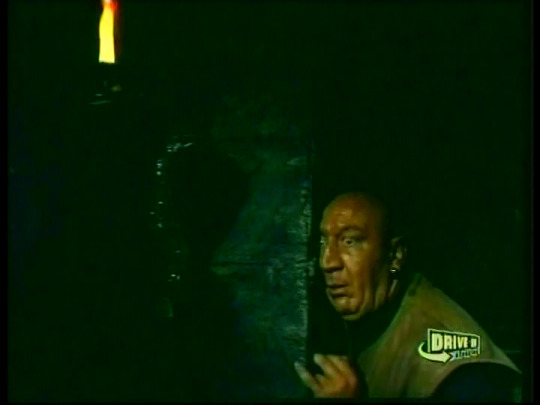
Quito in the crypt.
I want to shift focus now to the subject of zombies and their portrayal on SP, as well as what we know of Quito’s past. This section will contain references to slavery and suicide, so, if those subjects trigger you, you may wish to skip ahead to the next section, beginning with another copy of the photo of Quito looking into Chalcko’s birdcage.
Before I got into SP, I was long predisposed to dislike zombies because of the clichéd way that most horror movies and shows depict them: namely, as mindless creatures focused solely on eating human brains. Hordes of walking corpses who go on living only to consume and destroy are a useful metaphor for the effects of things like consumerism and social media addiction, but they don’t make for interesting characters; in fact, they make for rather dull ones, in my (highly unpopular) opinion.
But Quito was shown from early on to be a very different kind of zombie, almost the opposite of the Dawn of the Dead type. We see hints as early as Episode 12 that he has thoughts and feelings and now we have confirmation that he even has the capacity for love. He appears mindless, soulless, and unfeeling to some other characters, but those who know him well like Raxl and Jean Paul know that, despite his silence and his undead state, he has a mind, a personality, and even a heart. It doesn’t hurt that Kurt Schiegl gives Quito a great deal of expression and personality through his body language; we may not know exactly what thoughts are going through Quito’s mind, but we can get an idea. (And he never once expresses an interest in eating brains, which is another plus.)
The reason why Quito is so different from most modern portrayals of zombies is because he is based on an earlier conception of who zombies are and how they are created. In the traditional beliefs of Haitian Vodou, a zombie is created when a Vodou sorcerer or bokor resurrects a corpse to serve as his personal slave. While there are many theories as to when these legends originated, the most likely theory (which Mike Mariani argues in The Atlantic) is that they began during the period of French colonialism. During this period, which stretched from 1625 to the Haitian Revolution at the turn of the 19th century, most of the population of the island of Hispaniola (then known as Sainte-Domingue) was enslaved on sugar plantations, which required back-breaking, often deadly labor. This, combined with the other indignities of slavery, drove many enslaved Africans living there to commit suicide in an effort to return to their home countries. The idea that those who ended their own lives would be stuck on Sainte-Domingue eternally as zombies came about as a way or Haitians to discourage suicide. “Death was better than slavery for many – the suicide rate among Haitian slaves was very high. It was bad to be a slave,” Amy Wilentz writes in her review of the Vice documentary I Walked with a Zombie. “Worse would be to die and discover that, rather than returning to Africa, you continued to be enslaved as a dead person, run by a master, doing his bidding – and this is the fear that created the ‘Americo-normative’ zombie, as we know him.”
According to Mariani’s article, zombies did not become associated with bokors until after Haiti won its independence and subsequently abolished the institution of slavery. He calls this “the post-colonialism zombie, the emblem of a nation haunted by the legacy of slavery and ever wary of its reinstitution...The zombies of the Haitian Voodoo religion were a more fractured representation of the anxieties of slavery, mixed as they were with occult trappings of sorcerers and necromancy.” Wilentz associates this with “the fear of re-enslavement,” for “no one wanted to be dead, consciousness-less, and working for free for a master,” especially in a country that had fought so hard to rid itself of its shackles.
The show canon for Strange Paradise has not given--and will not give--much information about Quito’s backstory. What we do know is that he is a native of somewhere near Maljardin, descended from an indigenous Central American culture related to the Aztecs, and that was alive during the same period as Raxl. He was Jacques’ “servant” (more likely a slave) in the 17th century and, at some point before Jacques’ death, became a zombie. We also know from his reaction to the Conjure Man’s name in Episode 13 that the Conjure Man did something to him at some point that traumatized him, which may or may not have included the spell.
The Paperback Library novel Island of Evil, however, gets far more detailed about Quito’s backstory and shows his transformation into one of the undead. In the novel, Jacques forces Raxl to relive a particularly painful memory from the 17th century in order to coerce her into doing his bidding in the then-present. In her memory, Raxl visits the pregnant and bedridden Huaco des Mondes during a dinner party, although Jacques has forbidden them from meeting with each other. When he catches her returning from Huaco’s room, Jacques gets revenge on Raxl by stabbing Quito (who is her husband in the books) and then forces an African Vodou priest whom he recently purchased to resurrect him for his guests’ entertainment.[1] It’s worth noting that, like the zombies of Haitian folklore, the Vodou priest tells Raxl not to allow Quito to consume salt: “Should he eat either [salt or meat],” he says, “he will know he is a dead man.”[2] Thus the book canon connects Quito both to the horrors of slavery in the colonial-era Caribbean and to early zombie folklore, before zombies became the brain-eating monsters they are usually portrayed as today.

Quito checking on his adorable bird. Curt recently mentioned the possible connection between Chalcko, Huaco (Jacques’ “pigeon”), and Erica (Raxl’s “little bird”) in a post on his Tumblr, which was a piece of possible symbolism that had never occurred to me until then.
Dan reveals to Matt that Jean Paul has a Stanford-Binet IQ of 187. I’m noting this only because I’ve referenced it before in regards to Jean Paul’s alleged intelligence juxtaposed with his tendency to make stupid decisions. He may have an IQ of 187, but that only applies to his book smarts, not to common sense decisions like the knowledge that you should never make a deal with the Devil unless you are absolutely certain that the Devil won’t screw you over, or that you can defeat him through loopholes or some other, similar means. Even the smartest people--even those with an IQ of 187--can be manipulated, and that is true of Jean Paul, whom THE DEVIL JACQUES ELOI DES MONDES has successfully outsmarted. I wonder if he even suspects that Jacques has no intention on bringing Erica back to life, as he revealed fourteen episodes ago?

Holly talking to the cryonics capsule.
At the end of the episode, Holly visits the crypt to talk to Erica’s capsule. “ Mrs. Desmond,” she says, her hands on the capsule, “I want to say something to you. I don't know if you can hear or not, but I'm so afraid. I’m afraid of Quito, I’m afraid of my mother, and also of the Reverend. Mrs. Desmond, I’m so afraid somebody wants to kill me. But not your husband. I love him the way I love my father, but I'm so lost and so alone. Please help me...I want to know what it was that Quito and they saw in the picture.”
Quito catches her talking to the capsule and approaches her, his arms outstretched. “No, please!” Holly pleads, finally screaming and running from him, leaving the zombie with a heart alone in the crypt.
Upstairs, Holly calls for everyone to “see what you’ve done,” and the camera cuts to the portrait, which now bears a slash across the middle:
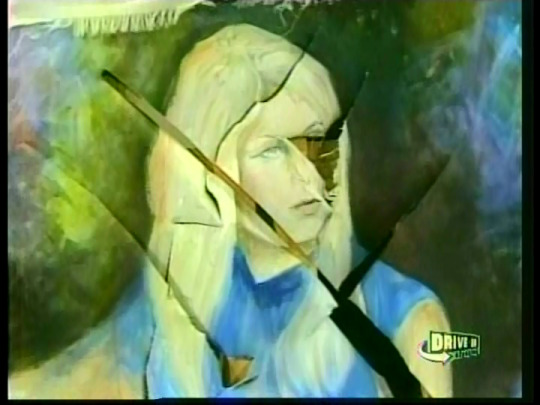
The end of the ill-fated saga of the Holly portrait.
“There is your spirit of love,” she cries, “or is it hate?” Alison, Matt, Dan, and Tim stare on, shocked and appalled by the slashed portrait and forever unaware of the identity of the culprit. The episode implies that the responsible party is Jacques Eloi des Mondes by showing a shot of his portrait glowing shortly before this scene, but this episode’s trivia on StrangeParadise.net indicates someone else. As with the trivia for Episode 30, it has to do with plot points that ultimately remained unexplained on the show, but nevertheless contains spoilers for the true nature of one character, so read at your own risk.
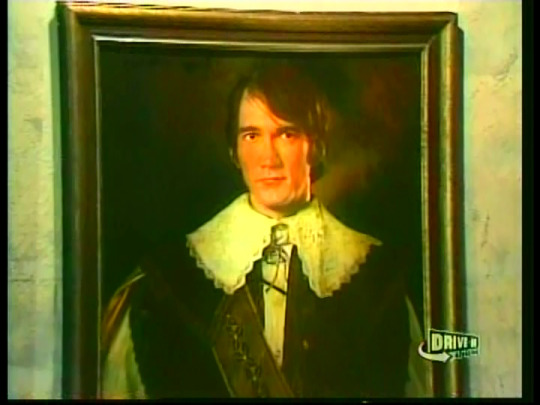
The first time since the pilot that Jacques’ portrait has glowed.
Coming up next: The characters react to the slashing of the portrait and we learn a telling bit of backstory about Elizabeth Marshall.
{ <- Previous: Episode 32 || Next: Episode 34 -> }
Notes
[1] Dorothy Daniels, Island of Evil (New York: Paperback Library, 1970), pp. 92-99. I will cover this book and the other two Paperback Library novels in more detail in a future series of posts.
[2] Ibid., p. 100.
#strange paradise#maljardin arc#ian martin#review#week 7#episode 33#foxless episodes#analysis#extra long corona edition#chalcko (quito's bird)#the damned holly portrait#historicalnote#iq of 187#maljardin blog#paperback library#17th century#speculation on ian martin's original story#unexplored plot point#unpopular opinions#zombies#my holly/erica/huaco/girl-sacrificed-by-tarasca theory may be my craziest one yet#the things i come up with when i should be sleeping
1 note
·
View note
Link
(NSFW warning for nudity and some racy language towards the end)
Since my review of the last episode with a costumed flashback is coming soon and I just read this article on real 17th-century French beauty ideals today, I figured it was the right time to post this.
#links#historicalnote#17th century#tl;dr jacques eloi des mondes would not have been considered hot in the real life 17th century#on a side note the portrait of philippe de lorraine is weirding me out#because irl i look like a female version of him#i wonder if i could be a lookalike descendant?#if so his portrait had better not start talking to me if i ever see it in person ;)
1 note
·
View note
Photo

Sort of a prelude to my next post, where I will give the first flashback on Strange Paradise the imitation Frock Flicks treatment. Tumblr, for some reason, shrinks images that are uploaded as part of a “text” post (as opposed to a “photo” one), so I am uploading this separately.
(Source for image on the right: Wikimedia Commons)
#historicalnote#costumes#jacques eloi des mondes#colin fox#historical fashion#1680s#louis xiv#17th century#strange paradise#gothic soap opera#maljardin arc
3 notes
·
View notes
Text
Episode 1 Review, Part II: Jacques’ Vintage 1630s Wedding Party
I meant to post this on Halloween, but this post took much longer than expected and I was too tired from work yesterday to write. So happy belated Halloween to anyone who is reading this and I hope that you find it interesting.
In my review of Episode 1, I wrote that I wanted to analyze the flashback from the episode in a separate post “because, despite being only a minute and a half long, there is a lot to unpack and I want to critique the costumes in addition to analyzing the content.” I am publishing this a little later than I originally intended (as the first part of this review took longer than I expected to write), but I don’t think that anyone minds.
Unlike the more famous Gothic soap opera Dark Shadows, which ran extended flashback arcs that lasted months, the flashbacks on Strange Paradise all lasted only a scene each and were infrequent. Maljardin had only three (although Ian Martin had planned at least one more (spoilers)), and the first half of Desmond Hall had none. Desmond Hall Part II had a lot, but none of them were costumed if the screencap slideshows I’ve seen from them are any indication. (I haven’t seen any episodes from 131 onward yet save some short clips, because I don’t currently have access to them. I have, however, read the synopses of 131 through 160 on this website and 161 through 195 on this old Yahoo! Group and looked at all the screencaps I could find, so I’m at least familiar with what happens and what the characters look like in the final arc.)
So let’s look at the first flashback, shall we?
Flashback
The flashback opens at a ball on Maljardin at some point in the late 1680s, with Jacques drinking from a huge red goblet while cheesy fake harpsichord music plays in the background. “Zounds, mon cher Jacques des Mondes,” a man in a beard and very obvious wig teases, “you are a poor chevalier! You marry a young beauty like this, but stand off in a corner drinking by yourself. That’s damned unchivalrous!” (I was about to write, “He might have said ‘monsieur‘ and probably meant to, but the guy’s French pronunciation is so bad that he honestly could have said either one.” However, I just pulled up the script to this scene* and discovered that he does indeed say “mon cher.” So I was right the first time.)

Madame Huaco des Mondes and Bad Wig Guy.
“And unromantic,” Madame des Mondes (Patricia Collins) adds, fluttering the feather fan she is holding despite Jacques obviously not paying attention to her. According to Episode 6, her first name is Huaco and the original draft of the script that I linked to in the last paragraph indicates that she “might be an Inca princess.” (The first two Paperback Library novels confirm this. while the third mistakenly calls her an Aztec princess.) Presumably, this means that she is of Inca royal blood and would have been a princess had the Spanish not defeated the Inca Empire in 1572, more than a century earlier. Or, alternatively, it could mean that Chevalier of Worlds Jacques traveled back in time to marry her, perhaps using the des Mondes family’s magical clock that is mentioned in a later episode.** There is also the possibility of a critical research failure on the writer’s part, but I love this show in spite of all its glaring flaws and so I want to try to justify this blatant anachronism.
Jacques--who is still clearly uninterested--approaches her and kisses her hand. “You do me wrong, my pigeon,” he says, comparing her to the likes of Speckled Jim. “To question your husband’s devotion?”

The newlyweds. Huaco looks really pretty in this shot, and Jacques is dashing as always.
“How could I not, when my eyes see your eyes on every woman in the room?” I’m not sure who talks like this. Presumably it sounds more natural in Huaco’s mother tongue. Either way, this is the first indication that Jacques is a womanizer.
“To compare, my dove,” he responds insincerely. “Your loveliness. So far above theirs.”
“Is it then my turn to bed?” she asks, grinning widely in a questionable acting decision that pushes this flashback to David Wells levels of so-bad-it’s-goodness. How many women has he bedded already on what is presumably their wedding night? Or before, to her knowledge?

Jacques, however, has other ideas: “First, let me show you the cliff heights at sunset,” he says, leading her outside. “And then my undying love.” This is followed by Bad Wig Guy laughing about the bed being in the other direction (when Jacques clearly said that he was going to show her the cliffs first), then the close-up of his smouldering face from the last entry, which seems to imply that he at least was contemplating pushing her from the cliff. I, however, doubt that he pushed her that day, considering that Bad Wig Guy’s dialogue implies that he just got married and that this is his wedding ball, and, by the time of the next flashback, Huaco (who is still alive then) has given birth to Jacques’ heir.
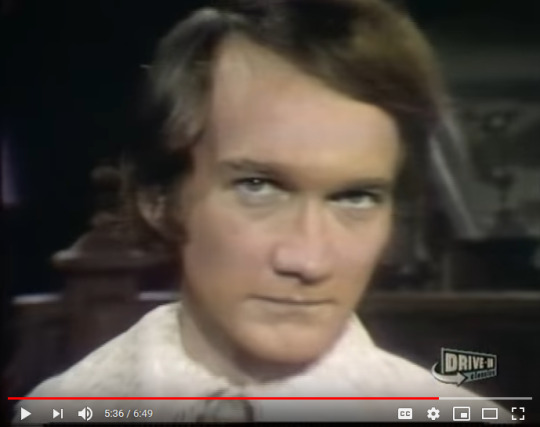
Costumes
Ever since I watched this show for the first time, I have wanted to take the flashbacks from Episodes 1, 6, and 20 and give them the Frock Flicks treatment. I’ve even thought about requesting a real Frock Flicks review of the flashbacks, but I fear that they’d judge the show too harshly, especially given the complete absence of the late 17th-century full-bottomed wigs they love so much. I, on the other hand, find full-bottomed wigs ugly, so I don’t mind their absence. In fact, I don’t really mind the absence of anything even remotely resembling what a French nobleman like Jacques Eloi des Mondes would have actually worn in the 1680s, because I’m not fond of most men’s fashions from the Louis XIV period.*** (If you are fond of them, good for you! There’s nothing wrong with liking periwigs or anything else that was fashionable in the Louis XIV era; they’re just not my taste. I prefer men’s styles with no/more naturalistic wigs and a broad-shouldered/narrow-waisted silhouette.) Nevertheless, I shall try to review the costumes as objectively as possible--and I shall try to keep it brief, because the amount of time I have already spent writing about Episode 1 alone has gotten me seriously questioning my life choices.
In late 17th-century France, fashionable dress for men consisted of a long coat called the justaucorps which reached to around knee length, a vest of equal length underneath, silk stockings, a lace cravat tied at the throat (sometimes with a ribbon to hold it in place), and an enormous long, curled periwig which, from 1675 until the 1690s, increasingly featured curls piled high on the crown of the head. Judging by this series of engravings of Louis XIV, who set the fashions of the era, noblemen’s justaucorps cuffs were often huge with voluminous shirt sleeves underneath. If you want more images of real 1680s men’s fashion, see this gallery on Kipar.org or this category and its subcategories on Wikimedia Commons.
Obviously, this style bears little resemblance to the clothes that Jacques and Bad Wig Guy wear, which are clearly patterned after styles from their grandparents’ generation. They most closely resemble the clothing popular in France in the 1630s, particularly post-1633 when Cardinal Richelieu passed an edict outlawing excessive decoration. (Source: Tom Tierney, Jacobean and Early Bourbon Fashions, p. 31.) Compare their outfits to that of Henri II de Guise (the grandson of that Duc de Guise) or this unnamed courtier. Obviously, there are some differences, most notably the higher waistline and the sleeve openings on Jacques’ doublet being on the outside of the sleeves instead of the inner seams like they are in every painting I’ve seen from this era. Jacques also has a massive baldric (the belt over his shoulder, which noblemen of the era used to hold their swords) compared to the men in the period images linked to above. But the aesthetic overall is very 1630s-esque, and it may be that Jacques and his friends are into 1630s vintage. ;)
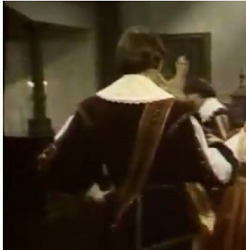
From Episode 20, carefully cropped to avoid spoilers. Jacques’ baldric is much wider and his waistline a few inches lower than that of Henri II de Guise or the courtier in the Bosse engraving. For some reason, he wears a baldric but not a sword, which is weird.
As for their hairstyles, they are not historically accurate. Jacques’ hairstyle is just a messier version of Jean Paul’s 1960s combover and not 17th century at all. Bad Wig Guy’s bad wig is about the right length for the 1620s (see here and here), but not curly enough. It goes without saying that neither one resembles a late 17th century periwig in the least. (Thank the Great Serpent! *makes wavy hand motions in air*) Bad Wig Guy’s beard is a very early 17th century style that I associate with King Henri IV of France, who died in 1610. It is also very much not the aesthetic of the Louis XIV period, when most men either shaved or wore a small mustache.
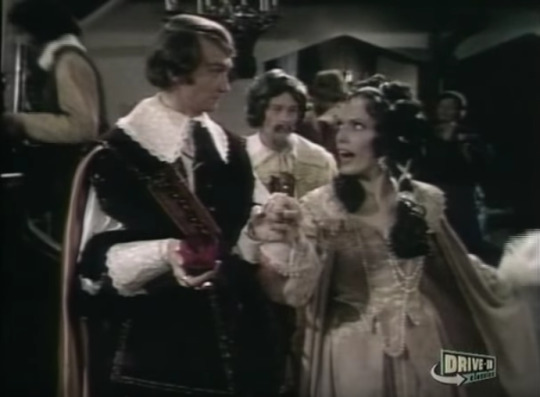
The best screencap I could get of Huaco’s dress.
Huaco’s outfit also bears little resemblance to 1680s French women’s dresses. In that period, fashionable French noblewomen wore dresses called manteaux that were cut in one piece (as opposed to as a separate bodice and skirt) over petticoats and conical corsets designed to push up their breasts. Necklines were low-cut and did not have collars, in contrast to styles in the first half of the century. (Source) In the late 1670s, Louis XIV’s mistress the Duchesse de Fontanges invented the fontange, a style that consisted of curls piled on top of the forehead and topped with a distinctive ruffled headdress. Here is a good engraving showing the style. See also this gallery on Kipar.org and this one on WIkimedia Commons.
The most noticeable differences between Huaco’s dress and the actual fashions of 1689 are (1) the lace collar and (2) the separate bodice and skirt, with tabs on the bodice. Both of these are more characteristic of English styles from earlier in the century, particularly circa 1630-1640. Compare the screencap of her dress above to this 1632 painting of Queen Henrietta Maria of England and her daughter Mary’s dress in this 1640 portrait (no tabs, but otherwise very similar). Also, I don’t think that she is wearing a 17th-century-style corset underneath, because her torso is not a rigid conical shape and her breasts are in their natural position. So, in short, more vintage 1630s for Madame des Mondes.
Her hairstyle is...fascinating, to say the least. It appears to consist of a bouffant decorated with large faux pearls and white ribbons and/or strings of more faux pearls, with tight curls around her face, pigtails resting on her shoulders and some loose hair hanging from the back of the bouffant. The decoration may have been inspired by images of early fontange hairstyles like the one from 1682-83 in the center of the first row on this page, but it does not resemble the more common fontange look. While there are some examples of beehive-like hairstyles in 17th century paintings with a similar shape (take Anne of Denmark for example, or the Spanish lady in this Velázquez painting), they are from much earlier in the century and don’t involve pigtails. Her makeup is definitely 1960s and not even close to any authentic 17th-century European looks, which rarely used noticeable eye makeup.
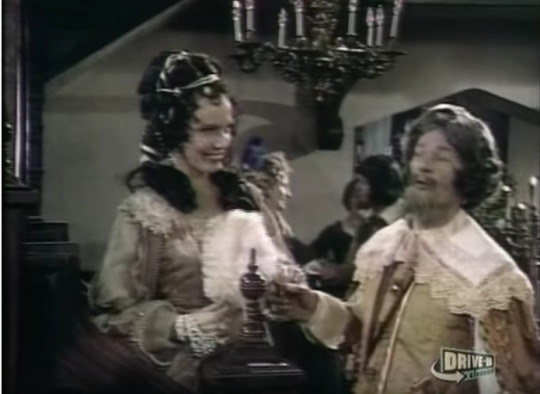
The best view that I could get of her hairstyle.
I think that Huaco’s bouffant may have been intended to imitate a head shape created by artificial cranial deformation, which the Incas practiced at least until the Spanish outlawed the practice in 1585. (More evidence, perhaps, for my “Jacques traveled back in time to marry Huaco” theory?) Alternatively, she could just have a bouffant because the pilot was filmed in the 1960s and TV shows and movies back then tended to put bouffants on characters in inappropriate historical periods. But I like my theory better, so I’m sticking with it.
In conclusion, the costumes in the flashback are a loose hodgepodge of styles from the early to mid-17th century, with some elements that are not from the period such as Jacques’ and Huaco’s hairstyles and Huaco’s makeup. I’m not certain whether the costume designer knew or cared that the styles weren’t even remotely accurate to the 1680s. Even so, I am only slightly ashamed to admit that I prefer this loose adaptation of 1630s men’s fashion to the styles that Jacques would more likely have actually worn were he a real person in 1689.
With this post, I am done writing about Episode 1, save perhaps to post more screencaps. My post about Episode 2 should be up sometime next week.
Notes
* This link is part of a series of webpages comparing the original draft of the pilot script to the final screenplay for Episode 1. Bryan Gruszka, the author of StrangeParadise.net, has some interesting commentary about it.
** Episode 60, to be exact (which was written by Cornelius Crane). Why the writers never did anything with the magical clock idea is beyond me.
***Now I feel like a hypocrite for making fun of the men’s “Elizabethan” costumes on A Discovery of Witches on my other blog for the lack of ruffs and trunk hose, when I have less of a problem with the historically inaccurate costuming on Strange Paradise. (Still, there is a huge difference between a modern high-budget drama based on novels written by a professional historian and a low-budget soap from the 1960s hastily thrown together to compete with Dark Shadows. One expects historical accuracy from the former but not the latter.) While Colin Fox probably would have still looked cute in a full-bottomed wig and 1680s justaucorps, I prefer his vintage 1630s(-esque) outfit.
{ <-- Previous: Episode 1, Part I || Next: Episode 2 --> }
#strange paradise#gothic soap opera#week 1#episode 1#maljardin arc#review#ian martin#anachronisms#analysis#costumes#flashback#historical fashion#historical hairstyles#historicalnote#jacques chevalier of worlds#the magical clock at fort desmond#17th century#1680s#sliding scale of episode quality#what am i doing with my life
2 notes
·
View notes
Photo

Link in bio for where to get hold of your copy of Intrepid Dudettes! :) Or head straight to books2read.com/idie #pocinhistory #indigenoushistory #storycraft #culturalnotes #historicalnotes #Spanishhistory #Ecuador #Peru #Chile #Bolivia #argentina #colombia #Ecuadorianhistory #Peruvianhistory #Chileanhistory #Bolivianhistory #Argentinianhistory #SouthAmericanhistory #SouthAmericanhistory #everythinghasahistory #histcomm #histwomen #histgender #historians #historyfeed https://www.instagram.com/p/CUXKATAAvEo/?utm_medium=tumblr
#pocinhistory#indigenoushistory#storycraft#culturalnotes#historicalnotes#spanishhistory#ecuador#peru#chile#bolivia#argentina#colombia#ecuadorianhistory#peruvianhistory#chileanhistory#bolivianhistory#argentinianhistory#southamericanhistory#everythinghasahistory#histcomm#histwomen#histgender#historians#historyfeed
0 notes
Photo

#Paperbacks and #ebooks for adults and kids. Well-researched history that doesn't push women to one side! Amazon: author.to/hpugh Also at #Smashwords #Vivlio #Tolino #ibooks #GooglePlay #Overdrive #BarnesandNoble #Scribd #Wattpad ... #womenshistory #historyforchildren #indigenoushistory #storycraft #culturalnotes #historicalnotes #Spanishhistory #Peruvianhistory #lovehistory #historyenthusiast #historyfan https://www.instagram.com/p/CLHWnzAAdPG/?igshid=15klso9svhi71
#paperbacks#ebooks#smashwords#vivlio#tolino#ibooks#googleplay#overdrive#barnesandnoble#scribd#wattpad#womenshistory#historyforchildren#indigenoushistory#storycraft#culturalnotes#historicalnotes#spanishhistory#peruvianhistory#lovehistory#historyenthusiast#historyfan
0 notes
Photo

*English version below* Chaque fois que je dois dessiner des intérieurs de tel ou tel autre palais je me maudis (car l'architecture c'est vraiment pas mon truc) mais j'essaie toujours de faire de mon mieux, car je crois que le lieux qui vivent les personnages sont eux-mêmes des protagonistes tout aussi importantes! (Mais au bout de ça il me faut des cookies pour me remettre 🍪🍪) • Everytime I have to draw an interior of a palace I blame myself (because yes, architecture isn't really my thing) but I try to do my best anyway, because I believe that the locations in which my characters are living in are protagonists as well (but at the end of this I need cookies to recover 🍪🍪) #Sisi #elisabethofaustria #kaiserinelisabeth #Sissi #elisabethkirályne #habsburg #budapest #dancehall #comics #bd #drawing #watercolor #aquarelle #dance #giorgiamarras #steinkis #1850s #ball #dance #Historicalnotes #maisondesauteurs #France #wip (presso Maison des Auteurs)
#dance#kaiserinelisabeth#aquarelle#comics#historicalnotes#watercolor#wip#elisabethkirályne#sissi#sisi#habsburg#1850s#drawing#france#dancehall#bd#ball#budapest#steinkis#maisondesauteurs#elisabethofaustria#giorgiamarras
3 notes
·
View notes
Photo

*English version below* Pendant un bal, tous les officiers militaires devaient s'habiller dans le respect des directives de leur armée, et ça c'est "du classique": la literature est pleine d'exemples des "victimes" du charme distingué de l'uniforme. Pourtant, les dames n'étaient guère contentes de pouvoir danser avec les officiers de la cavalerie. Pourquoi? Parce que pour obéir à la règle d'avoir une uniforme parfaite, ils devaient porter des haut bottes en cuir parfaitement polis. Le problème était que les officiers en dansant tachaient de cire noire les précieuses robes des dames présentes. Un vrai cauchemar, puisque cela signifiait devoir jeter un gran nombre des robes! 😱 • During a ball, all the military officers had to dress in the respect of the directives of their army, and this is "a classic": the literature is full of examples of the "victims" of the distinguished charm of the uniform. However, the ladies were not happy to dance with cavalrymen in particular. Why? Because to obey the rule of having a perfect uniform, the cavalrymen had to wear perfectly polished high leather boots. The problem was that during the dance these officers stained with black polish the precious dresses of the ladies. A real nightmare, since it meant to end up in throwing away a lot of fancy dresses! 😱 #Historicalnotes #Sisi #elisabethofaustria #kaiserinelisabeth #sissi #erzsebetkiralyne #empress #history #19thcentury #hofburg #vienna #wien #osterreich #Habsburg #dancing #bal #drawing #wip #comics #bd #comics #giorgiamarras #watercolor #aquarelle #steinkis
#sisi#wien#dancing#habsburg#giorgiamarras#sissi#drawing#erzsebetkiralyne#bd#bal#historicalnotes#watercolor#elisabethofaustria#19thcentury#kaiserinelisabeth#steinkis#empress#wip#aquarelle#comics#osterreich#hofburg#history#vienna
1 note
·
View note
Photo

*English version below* Le saviez-vous? Il peut sembler étrange mais dans un bal officiel la danse n'était pas l'élément essentiel de la soirée... parce que il n'y avait pas assez de place pour tout le monde! 😉 Toutefois, le "cotillion" était le moment le plus haut de cette activité. Les couples qui étaient en train de le danser étaient observés par l'aristocratie entière avec grande curiosité. La raison? Parce que danser deux fois le cotillion signifiait s'être fiancés! Did you know it? It sounds strange, but in a official ball dancing was not the focus of the soiree... Because there was not space enough for everyone! 😉 Besides, the "cotillion" was the most significant moment of that activity. The couples who were dancing it were observed with the greatest curiosity by all the aristocracy. The reason? Because dancing twice the cotillion meant that the couple become engaged at that very moment! #Historicalnotes #Sisi #Elisabethofaustria #Kaiserinelisabeth #sissi #erzsébetkirályné #empress #dancing #ball #dancehall #history #19thcentury #ballgown #Habsburg #drawing #wip #comics #bd #budapest #1800s #watercolor #aquarelle #Steinkis #giorgiamarras #maisondesauteurs #france (presso Maison des Auteurs)
#giorgiamarras#historicalnotes#sisi#maisondesauteurs#elisabethofaustria#bd#watercolor#1800s#history#france#budapest#steinkis#erzsébetkirályné#ball#empress#drawing#aquarelle#comics#habsburg#ballgown#19thcentury#dancehall#dancing#wip#kaiserinelisabeth#sissi
1 note
·
View note
Photo

*English version below*⠀ ⠀ Voici un très rare moment d'intimité entre Elisabeth et Franz. Normalement les gens de ce rang étaient déshabillés et préparés pour la nuit par des femmes de chambre et des valets. Mais je voulais leur faire avoir une conversation privée, au bénéfice du récit. Historiens, pardonnez-moi! 🙃 ⠀ This one is a very rare moment of intimacy between Elisabeth and Franz. Normally people of their rank always got undressed and prepared for the night by maids or valets. But I wanted to let them have a private chat, for the story's sake. Historians, please, forgive me! 🙃 ⠀ #Sisi #Elisabethofaustria #KaiserinSisi #Kaiserinelisabeth #Empress #19thcentury #Habsburg #drawing #wip #comics #bd #budapest #1800s #watercolor #aquarelle #Steinkis #giorgiamarras #maisondesauteurs #france #night #lights #mirror #miroir #Historicalnotes (presso Maison des Auteurs)
#empress#lights#maisondesauteurs#france#1800s#habsburg#watercolor#drawing#night#kaiserinelisabeth#aquarelle#mirror#sisi#wip#steinkis#19thcentury#bd#budapest#historicalnotes#kaiserinsisi#miroir#elisabethofaustria#giorgiamarras#comics
1 note
·
View note
Photo

Quando fuori è notte. ⠀⠀ ⠀⠀ #Sisi #Elisabethofaustria #kaiserinsissi #kaiserinelisabeth #queen #kaiserin #erzsebethkyraline #sissi #horseriding #horse #cheval #night #forest #habsburg #drawing #comics #fumetto #bd #illustration #1800s #watercolor #aquarelle #dessin #Steinkis #giorgiamarras #history #historical #historicalcomics #historicalnotes #sissiunefemmeaudeladucontedefees https://www.instagram.com/p/Bw1khgChqyS/?igshid=o1acrh4eo1t
#sisi#elisabethofaustria#kaiserinsissi#kaiserinelisabeth#queen#kaiserin#erzsebethkyraline#sissi#horseriding#horse#cheval#night#forest#habsburg#drawing#comics#fumetto#bd#illustration#1800s#watercolor#aquarelle#dessin#steinkis#giorgiamarras#history#historical#historicalcomics#historicalnotes#sissiunefemmeaudeladucontedefees
3 notes
·
View notes
Photo

Maybe it's because the summer isn't that far away or maybe it's just because in this moment I'm in my hometown where I can see the sea everyday (long cry - how much I miss it in my life I can't even tell), but today I feel like to post one of my favourite sequences of my whole book, Sisi in Madeira. Take that, ladies and gentlemen! 😏✨ ⠀ ⠀ #Sisi #Elisabethofaustria #kaiserinsissi #kaiserinelisabeth #queen #kaiserin #erzsebethkyraline #sissi #habsburg #madeira #seaside #sea #beach #drawing #comics #fumetto #bd #illustration #1800s #watercolor #aquarelle #dessin #mer #Steinkis #giorgiamarras #history #historical #historicalcomics #historicalnotes #sissiunefemmeaudeladucontedefees https://www.instagram.com/p/BwZrhgKFElH/?utm_source=ig_tumblr_share&igshid=1uuwuw6frajgn
#sisi#elisabethofaustria#kaiserinsissi#kaiserinelisabeth#queen#kaiserin#erzsebethkyraline#sissi#habsburg#madeira#seaside#sea#beach#drawing#comics#fumetto#bd#illustration#1800s#watercolor#aquarelle#dessin#mer#steinkis#giorgiamarras#history#historical#historicalcomics#historicalnotes#sissiunefemmeaudeladucontedefees
2 notes
·
View notes